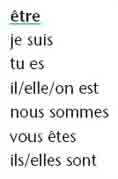1.1.3 Activités 2 et 3
Activité 2
Listen to Extract 40 in which you ask Christine where three places are. Speak after each prompt. The first one has been done as an example.
Écoutez l'extrait 40 et parlez dans les pauses.
Exemple
You hear: The post office.
You ask: La poste, c'est où?
Christine answers: C'est cours Président Kennedy.
Answer
Dialogue Here is the dialogue in full:
Posez les questions après les indications en anglais.
Numéro 1
The post office
Vous La poste, c'est où?
Christine C'est cours Président Kennedy.
Numéro 2
The town hall
Vous La mairie, c'est où?
Christine C'est place de l'Horloge.
Numéro 3
The police station
Vous Le commissariat, c'est où?
Christine C'est quai Saint Lazare.
Using ‘être’
Il/elle est
Below are examples of talking about nationalities using part of the verb être (to be):
Elle est anglaise. She's English.
ll est irlandais. He's Irish.
ll and elle are not only used to replace the name of a man or a woman, but also masculine and feminine nouns.
Le musée? IL est juste là, à droite.
The museum is just there, on the right.
La mairie? Elle est au bout de la rue.
The town hall? It's at the end of the street.
On est, nous sommes
In Extract 39, you also came across two ways of saying ‘we are’: nous sommes, which is slightly formal, and on est which is considered more informal:
Nous sommes où exactement? Where are we exactly?
On est là. We are here.
Je suis, vous êtes, tu es
To say ‘you are’ use vous êtes/tu es and je suis for ‘I am’.
Vous êtes français(e)? Are you French?
Non, je suis belge. No, l'm Belgian.
Vous is used in the singular and the plural. Tu is only used in the singular and when talking to people you know well.
Ils/elles sont
Finally, ‘they are’ will be translated as ils sont or (when talking about either a group of women or feminine nouns) elles sont.

Activité 3
The following sentences are extracts from a dialogue between a tourist asking for directions and a passer-by. The sentences are not in the correct order. Fill in the gaps with the correct form of the verb.
Complétez avec la forme correcte du verbe ‘être’.
(a) Oui, je ____________ d'Avignon.
(b) La mairie ________ place de l'Horloge.
(c) C'____________ loin?
(d) Où ____________ la mairie, s'il vous plaît?
(e) Pardon madame, vous_______de la région?
(f) Non, regardez, nous (i) _____________ ici, rue de la République et la mairie (ii) ___________ là!
Recreate the dialogue by putting the sentences in order.
Remettez les phrases dans l'ordre.
Answer
(a) suis (b) est (c) est (d) est (e) êtes (f) (i) sommes (ii) est
The correct order is e, a, d, b, c, f.
